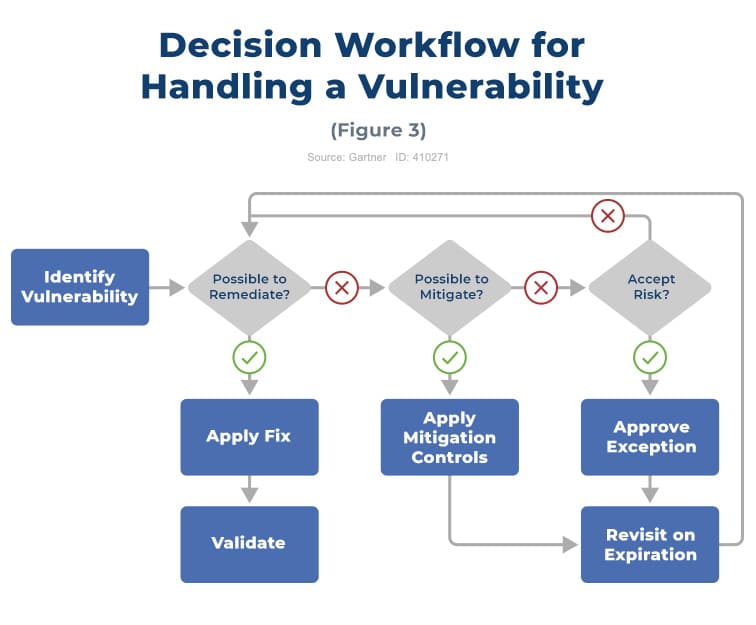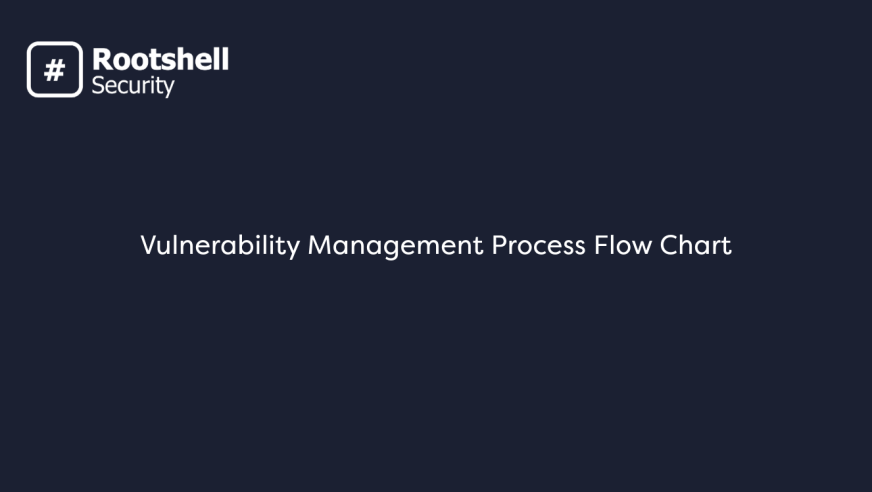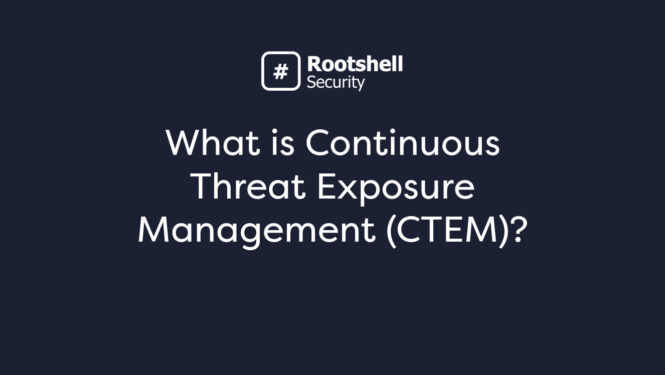Vulnerability management is essential to every modern cyber security strategy. However, it’s impossible to fix every issue discovered by vulnerability scans or penetration tests. A Vulnerability Management Process Flow Chart can guide IT security teams’ decision-making to ensure they take the best steps for the safety of their organizations.
Read on to learn about how a Vulnerability Management Process Flow Chart can benefit you.
What is Vulnerability Management?
Vulnerability management is the process of identifying, evaluating, prioritizing, and remediating security flaws within an organization’s network, systems, and applications.
The goal of vulnerability management is to ensure that organizations have complete visibility and control of weaknesses that exist within their IT estates on a continuous basis.
The terms ‘vulnerability management’ and ‘vulnerability assessment’ are oftentimes used interchangeably, but they have different meanings. Vulnerability management encompasses the end-to-end process of managing security issues, whereas a vulnerability assessment is a type of IT security test that discovers security issues within an organization’s network.
Why is Vulnerability Management Important?
Vulnerability remediation is an essential part of an organization’s IT security strategy.
Effective vulnerability management helps IT security teams ensure that critical issues are discovered, analysed, and remediated as fast and efficiently as possible. This is critical to minimizing an organization’s attack surface and preventing cyberattacks, which could have devastating consequences for an organization’s data, personnel, and reputation.
Vulnerability management also helps organizations allocate resources more effectively. Not all security vulnerabilities pose the same risk, and many may not even need to be remediated.
Another reason why vulnerability remediation is so important is that an organization’s threat landscape is ever-changing. The cyclical process of vulnerability remediation helps security teams assess and measure their security posture on a continuous basis so that there is very little opportunity for critical issues to be left unaddressed.
What is the Vulnerability Management Process?
Vulnerability management starts with the discovery of security issues and concludes with validating whether remediation has been successful, before repeating continuously.
It’s essential that the vulnerability remediation process is continuous, as new vulnerabilities could emerge at any time, and pre-existing vulnerabilities could become more critical.
We have summarised the complete process of vulnerability remediation below.
- Discover: Identify vulnerabilities within your organization’s network by carrying out vulnerability assessments.
- Consolidate: Centralise your assessment results in one place. This could involve transferring results from PDFs to a standardised database.
- Assess: Analyse your vulnerabilities to establish their severity, the likelihood that they will be exploited, and what impact they could have on your organization.
- Prioritize: Assign severity scores to your assets in line with your analysis, and other factors such as resource availability.
- Remediate: The vulnerability management remediation phase involves implementing your remediation program to resolve vulnerabilities in line with your organization’s priorities.
- Re-assess: Verify whether your remediation efforts have been successful. Ultimately, your vulnerability management process should reduce the risk of your organization being compromised.
- Visualize and improve: Continuously improve your vulnerability management process; resolve any bottlenecks and ensure compliance with your organization’s service level agreements. For example, could you reduce your time-to-remediate (TTR)?

Vulnerability Management Process Flow Chart
Now we’ve covered the Vulnerability Management Process, what about the process of handling specific vulnerabilities? Not all vulnerabilities are managed the same way – for example, a patch may not be available, or your organization may not have enough resources to fix every ‘medium’ issue.
A Vulnerability Management Process Flow Chart is a useful way of considering how to remediate vulnerabilities on a case-by-case basis.
Gartner’s Vulnerability Management Process Flow Chart shows the different decisions you can make when considering remediation and the subsequent actions:
- Is it possible to remediate? Yes/No
- Is it possible to mitigate? Yes/No
- Can you accept risk? Yes/No

Next Generation Vulnerability Remediation
The Rootshell Platform is a vendor-agnostic vulnerability remediation solution. It enables you to manage results from any type of IT security assessment, including penetration tests, giving you the unique advantage of analysing different assessment results alongside each other, in one standardized format.
The Rootshell Platform’s unique features help you accelerate every stage of the vulnerability remediation process and enhance efficiency from start to finish.
Learn more about vulnerability remediation management tools.
How The Rootshell Platform Improves Every Stage of Vulnerability Remediation
- Consolidate Your Supplier Assessment Data: Import any assessment result into The Rootshell Platform; store data from any penetration testing vendor or security service provider in one centralized hub.
- Integrate and Standardize Your Assessment Data: Generate a database for your results in one consistent format. No longer analyse assessment results in silos; view data from different threat assessments alongside each other.
- Contextualize and Prioritize Your Assessment Data: Receive real-time insights and gain greater context of your issues, helping you prioritize most effectively.
- Streamline Your Remediation Workflow: Make remediation faster and more efficient, with third-party integrations, collaboration tools, real-time updates from testers, and more.
- Track and Validate Your Remediation Results: Measure your remediation efforts against your service level agreements and track key metrics, such as your monthly remediation rate. Read more on vulnerability management metrics.
- Visualize and Analyse Technical Risk Across the Whole Organization: Gain a holistic view of your global threat landscape; effortlessly analyse your technical risk with insightful dashboards and automated reporting.



